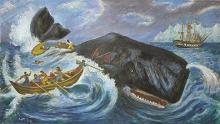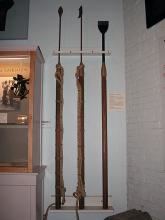What About Whaling?
Whaling was a minor Maine fishery. In the seventeenth and eighteenth centuries a few hunted whales from the shore and a few places continued whaling into the nineteenth century: Vinalhaven, Winter Harbor, Prospect Harbor, and Mount Desert Island.
Whalers from Portland, Wiscasset, Bath, and Bucksport made some trips to the Pacific in the 1830s and 40s, but could not compete with whaling communities such as New Bedford, Nantucket, and other southern New England ports.
In shore whalingShore whaling
Whaling method using boats that set out from shore and then processed the whales on shore. It was practiced in many areas where whales pass close to land., the whale was harpoonedHarpoon
A spear-like weapon whose head was designed so that it would not pull out of the hunted animal. It was attached to a line. It has been used in hunting whales, seals and walruses, as well as in catching sword fish., allowed to tire itself out, then lanced from boats rowed from shore. Whalers towed the whale to tryworksTryworks
The stoves used to melt marine mammal blubber, chiefly from whales, into oil. set up on shore. BlubberBlubber
The layer of fat found under the skin of marine mammals like whales, porpoises and seals. It stores energy and serves as an insulator. Heated, it can be rendered or melted into oil. flensedFlense
Stripping the blubber and skin from a marine mammal. from the whale was renderedRender
To melt fat or blubber to remove impurities. into oil. Whale oil was valuable for illumination before keroseneKerosene
A mixture of liquid hydrocarbons obtained by distilling petroleum or shale, and used as a fuel. and electricity. Right whales contained the most blubber and were most desirable. Today, right whales are an endangered species. Fin, humpback, and minke whales are the most common whales found along the Maine coast. To protect them, modern fishermen must use gear that will break if entangled with a whale.


